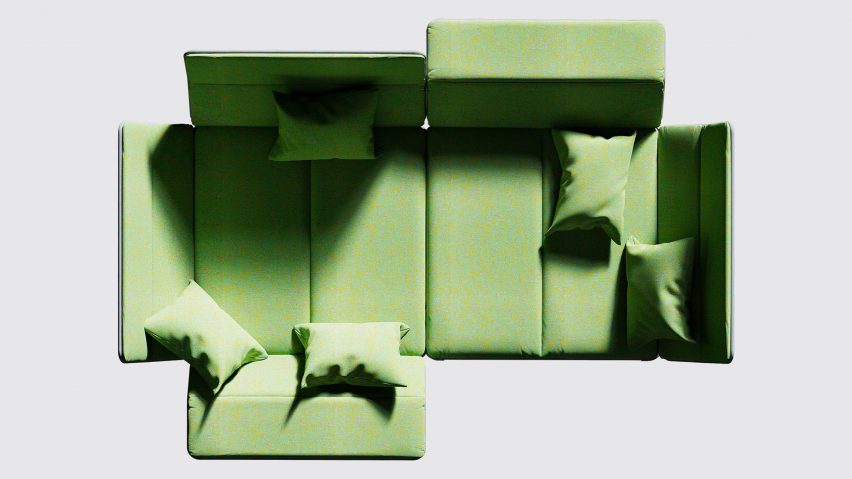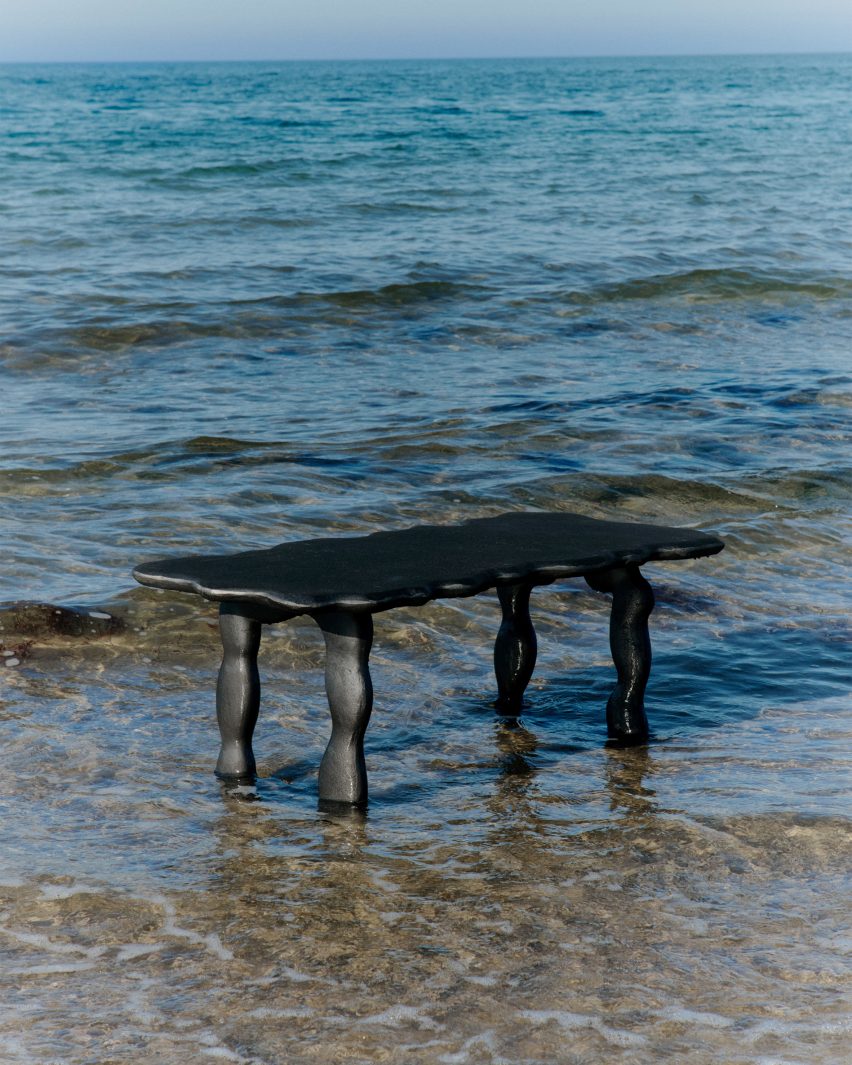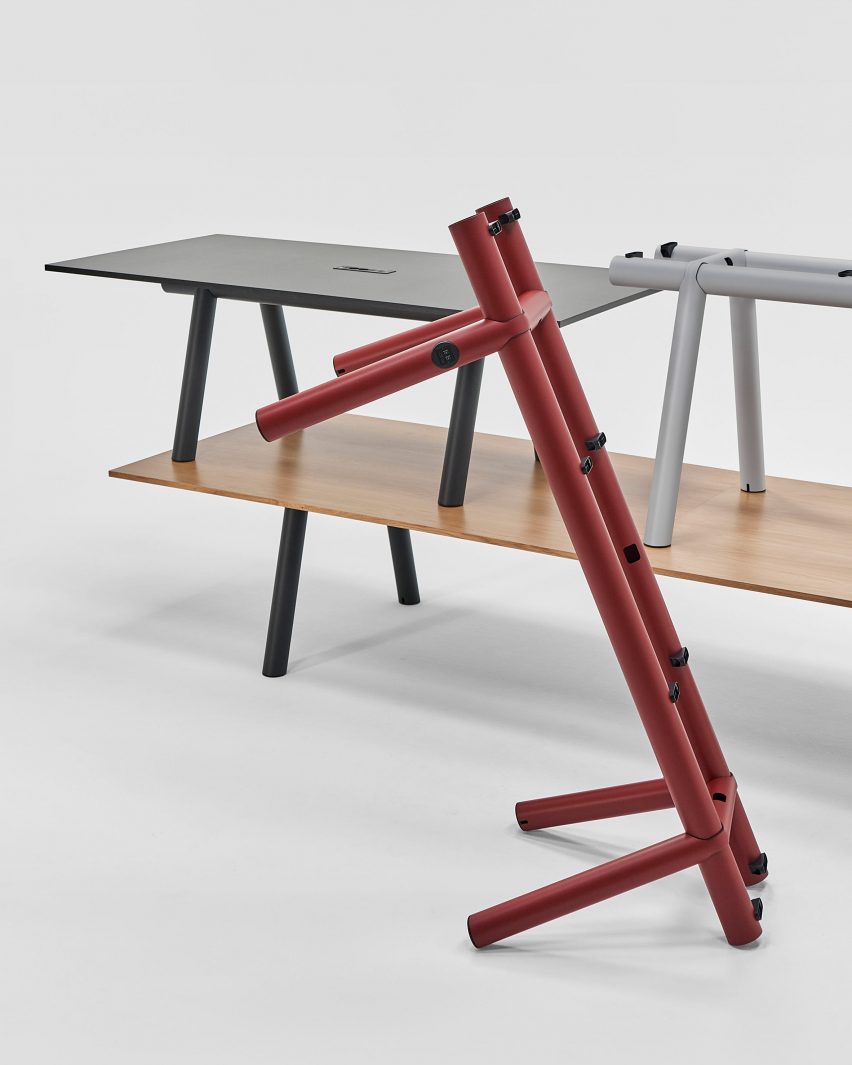Dezeen editor-at-large Amy Frearson reveals her 10 top trends from the 2023 edition of design festival 3 Days of Design in Copenhagen, including the resurgence of pine wood and sofas of the future.

Feeling pine
Pine trees are one of the fastest-growing sources of wood on the planet, which in the past led to this timber becoming synonymous with "cheap and cheerful".
But today, with sustainability at the top of the agenda for many designers and brands, this readily available and highly robust softwood is experiencing a revival.
Danish brand Normann Copenhagen had a range of raw pine objects on display during 3 Days of Design, including the Plank bookcase and Fyr stool. But the star of the show was the Notch bed – a first for the brand – which boasts overlapping joints at its corners.
Elsewhere, Finnish company Vaarni teamed up with Danish studio Tableau to show how Nordic pine can be used to create designs that are so well crafted that they look at home in a gallery.

Touch wood
The tactile qualities of timber were another important focus, with many designers creating objects and products that celebrate the patterns and imperfections within wood's natural grain.
Three, an exhibition by the American Hardwood Export Council (AHEC), featured experimental works by Scandinavian designer-makers Anne Brandhøj, Pia Högman and Anna Maria Øfstedal Eng.
The most surprising of the three were Brandhøj's pieces – a trio of consoles featuring cavernous openings that begged to be touched.
Italian designer David Dolcini followed a similar approach with TimeMade, an exhibition of ambiguous wooden objects that symbolised the passing of time.
Danish design studio Christian + Jade also explored the subject in the Weight of Wood exhibition, which explored the history of wood as a commodity.

Sofa, so good
Sofas are notoriously one of the most challenging types of furniture to ship, but they are also very difficult to clean, repair and recycle.
Danish brand TAKT has tackled these problems with Spoke Sofa, a design by Norwegian studio Anderssen & Voll. The sofa has an exposed timber frame and separate cushions, making it easy to replace or repair components that wear out.
Copenhagen-based design research lab Space10 has taken the idea even further, in collaboration with design and tech studio Panter & Tourron.
With help from AI, they have conceptualised how the sofa might become an object that is so lightweight that it can be folded like an envelope, allowing it to be reconfigured or packed up and carried to different locations.

Fashion-forward
The worlds of fashion and homeware are beginning to blur, with some furniture brands unveiling capsule collections that reflect the same design ethos that can be found in their core product ranges.
Leading the pack is Danish brand Gubi, which has teamed up with New York-based menswear label Noah on a five-piece swimwear collection, designed to match a colourful new edition of its MR01 Outdoor Lounge Chair.
Meanwhile, design brand Hay has worked with Danish designer Tilde Bjerregaard on the Outline Pyjama Collection, a range of sleepwear that matches its existing Outline Bedding and is also stylish enough to be worn by day.

Rising talents
During the pandemic, many brands chose to play it safe by working with well-known international designers, rather than taking risks on up-and-coming names.
That trend is finally shifting, with new talents taking centre stage during 3 Days of Design.
Danish homeware brand Ferm Living made young Norwegian designer-maker Anna Maria Øfstedal Eng the star of their show, with the launch of her sculptural Dal Piece table made from cast recycled aluminium.
Furniture brand Fora Projects launched its latest collaboration with Bahraini Danish, the neatly crafted BD side table and stool, while shelving brand Montana celebrated its partnership with colour expert Margrethe Odgaard.
British designer John Tree, a long-term collaborator of Jasper Morrison, also took the spotlight with designs produced by Hay and newly launched brand NINE.

Gender imbalance
A worrying trend in Copenhagen was the number of brands showcasing collections primarily made up of male designers.
In its debut presentation at an international furniture fair, Canadian brand Man of Parts unveiled collaborations with five designers and studios, with only one woman in the mix.
New company NINE followed a similar format, with only one woman among the nine designers in its launch collection.
Both brands have said that collaborations with more women are in the works.

Glass of their own
The world of glassware can often be very traditional, but a handful of designers are out to prove that this material can surprise and delight in new ways.
Danish lighting brand Louis Poulsen invited New York duo Home in Heven – best known for its viral collaboration with French fashion label Coperni – to rework its Pale Rose Collection.
The eye-catching results feature swirling shapes, horns and tentacles.
Danish designer Helle Mardahl also made a big impression with her exhibition The Sensory Society, where new designs include a playful take on the wine glass.

Extrude awakening
As a material that can be infinitely recycled, aluminium has become an important focus for brands looking to reduce their carbon footprint.
In its extruded form, the metal offers a strong and lightweight solution for furniture.
The most innovative example was on show at Hay, where the brand worked with German designer Stefan Diez to rework a design he originally developed using bamboo.
Boa is a conference table with a tubular aluminium frame, made using 75 per cent recycled, post-consumer waste.
Hay's new offerings also include the Apollo Chandelier, a contemporary lighting design that combines curving aluminium tubes with minimalist glass shades.

Bigger and better
The ongoing trend for chubby furniture forms, as first identified by Dezeen columnist Michelle Ogundehin in 2020, is still going strong.
Back then, Ogundehin saw this as a symbol of our search for comfort in dark times. Now, it could represent a market shift towards objects that will last a long time, potentially impacting the planet less.
A good example is furniture brand Muuto's Midst Table, designed by Sweden's TAF Studio. First unveiled in Milan in April, this round dining table centres around a chunky cylinder that is emphasised by a high-gloss finish.
New launches from Danish brand Fredericia include the Hugo Passos-designed Gomo, a lounge chair with a curvaceous profile, and the Cecilie Manz-designed Niveau, a range of wide-based coffee tables.
Elsewhere, furntiure brand Fogia unveiled Softcolumn, a table created by Swedish designer Björn Dahlström that has its legs hidden behind curtains for a theatrical feel.

In the elements
Outdoor furniture takes a long time to develop. This is because, as well as looking attractive, it has to hit a sweet spot in terms of weight – light enough to move, but heavy enough to resist blowing over – and it has to be weather-proof.
Many furniture brands started working on outdoor ranges for the first time during the pandemic, so there is now a wide range of new products hitting the market.
Our pick includes 19 Outdoors by NINE, a series of versatile chairs, benches and tables designed by design duo the Butterfield Brothers, as a development of the 19 Chairs project they developed during the Covid-19 lockdown in 2020.
Heritage brand Carl Hansen & Son unveiled AH Outdoor, an 11-piece collection designed by the late Alfred Homann.
Danish brand Fritz Hansen has also moved into outdoor furniture, thanks to its recent acquisition of specialist brand Skagerak. New launches included the Blanco bench by Hugo Passos.
3 Days of Design took place in venues around Copenhagen from 7 to 9 June 2023. See Dezeen Events Guide for information, plus a list of other architecture and design events taking place around the world.
"furniture" - Google News
June 16, 2023 at 05:15PM
https://ift.tt/L85mMyd
Pine furniture and future-facing sofas among top trends from 3 Days of Design - Dezeen
"furniture" - Google News
https://ift.tt/HqlYLTt

No comments:
Post a Comment